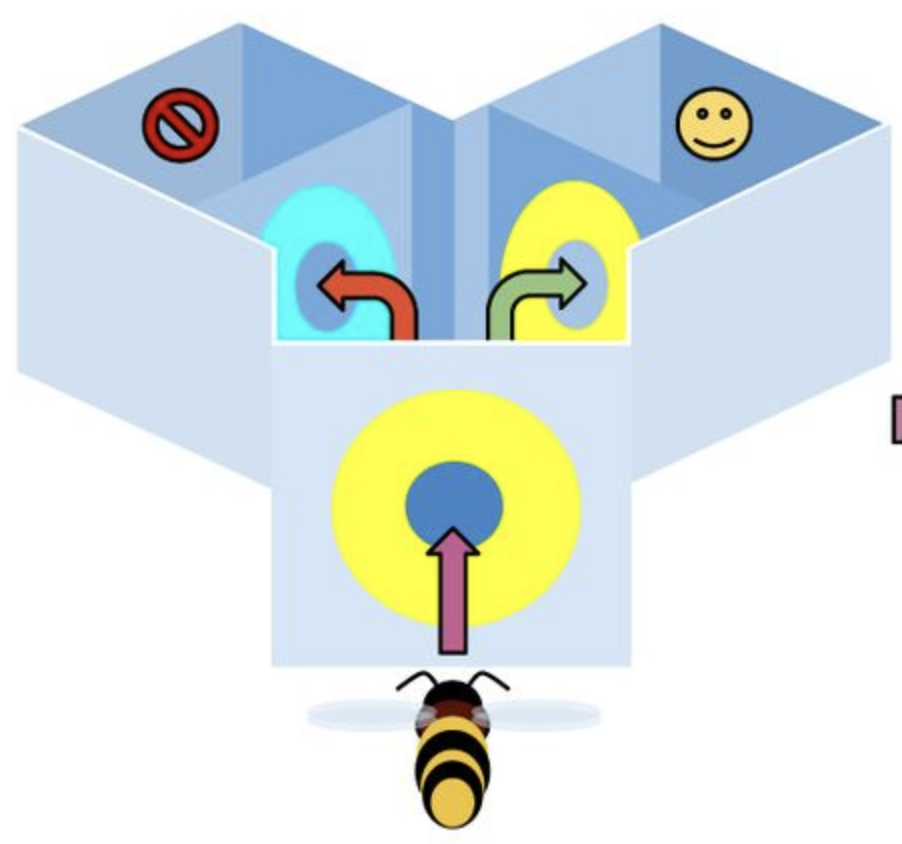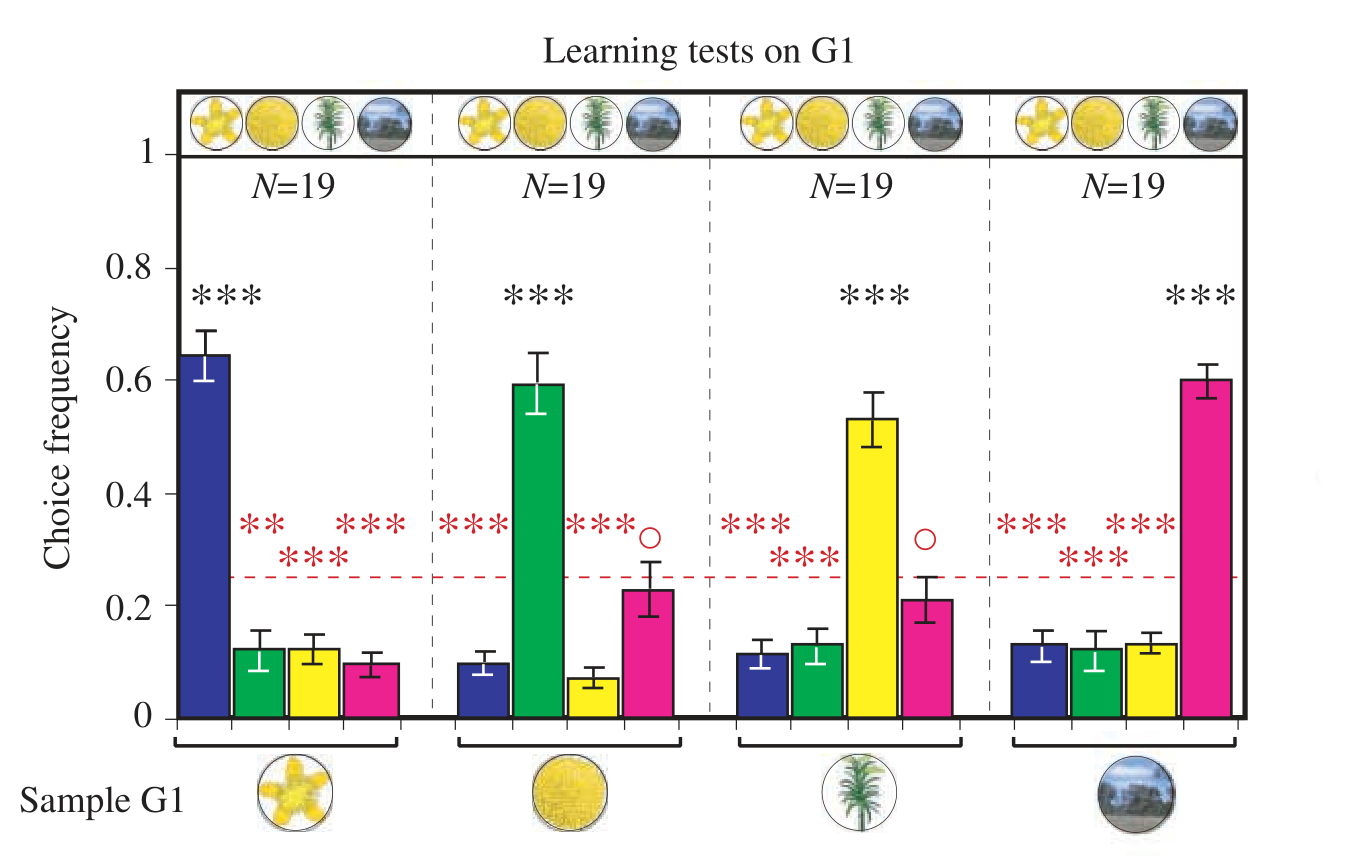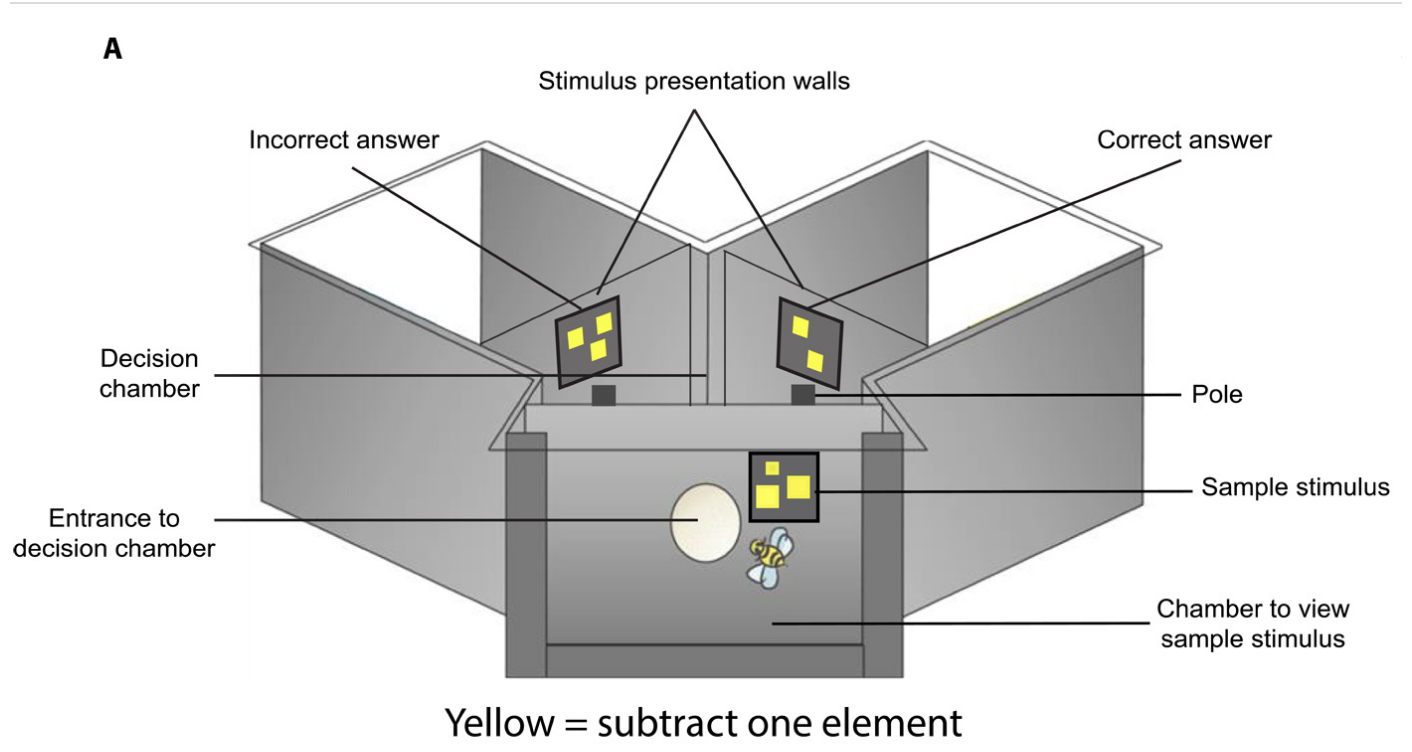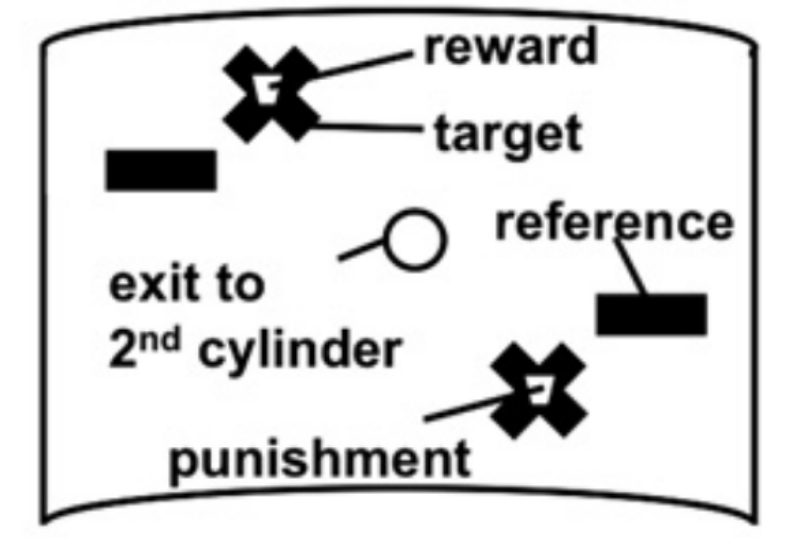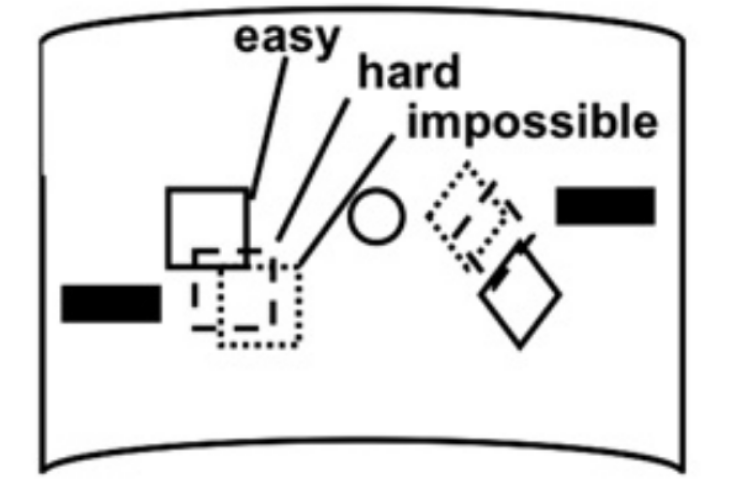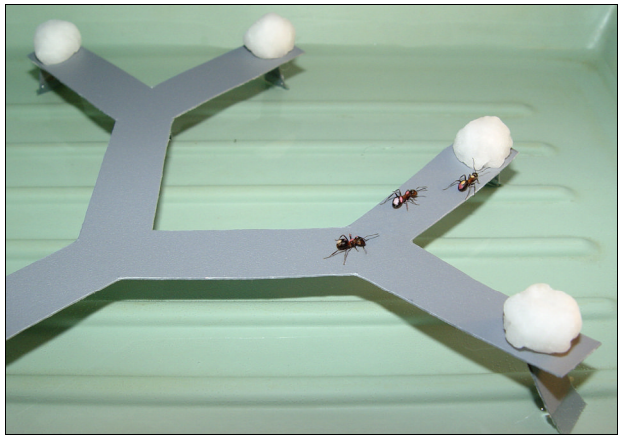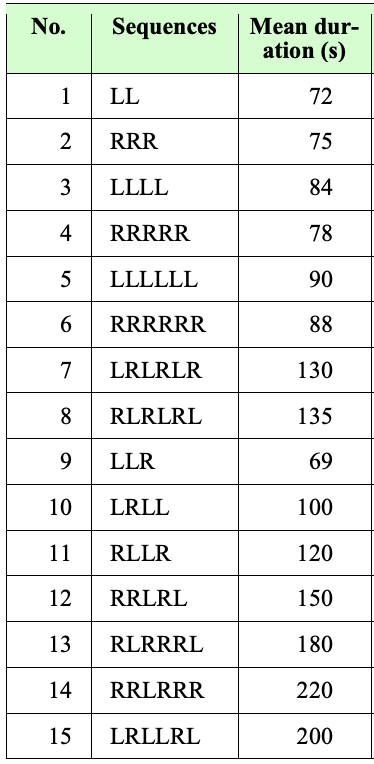Table of Contents
Cognitive capabilities of insects
This is a list of animals with small brains and their performance on relatively advanced cognitive tasks.
Honey Bees
Honey bees have around one million neurons1) and one billion synapses.2) For context, the human brain has 86 billion neurons3) and 1,000 trillion synapses4) (making it 4-6 orders of magnitude larger).
Common Methodology
Many of the following studies make use of Y-mazes (or variants thereof) to test insect capabilities.5),6),7),8),9),10) Y-mazes consist of two chambers—in the first room the insect sees a single stimulus (e.g., a yellow shape). The insect is then released into the second chamber where there are two choices. For instance, if a researcher were trying to test whether a bee had the concept of “sameness,” she might put a yellow shape in the first chamber, and a yellow and blue shape in the second chamber (pictured below11)). If the bee flew to the yellow shape it would receive a reward (and a punishment if it flew to the blue shape).
In order to test whether the bees can generalize the concepts (rather than merely finding associations), researchers will often test the insects on stimuli that weren’t present during training (these are called ‘transfer tests’). For instance, if the bee was trained on blue and yellow shapes, the experimenter might test it on green shapes. These studies also typically tried to control for possible confounds (e.g., researchers made sure to change shapes, colors, and sizes to avoid possible associations the bees might be making between the initial and final stimuli).
Category Extension
Honey bees have been observed to extrapolate category membership after only a few instances of seeing that category. For example, in Zhang et al.12) and as reviewed here13) honeybees were first trained to, upon first seeing an image in one chamber of a Y-maze, fly to the identical image in the next chamber for a reward. They learned how to do this successfully for star shaped flowers, circular flowers, stems, and landscapes after 20 training rounds for each category on average.
Then, the bees were tested on whether or not they would fly to a novel image from the same category they had seen in the first chamber. In the figure below, the sample section displays what image the honeybees were shown (these are the images it was trained on), and the choice frequency demonstrates which image they flew to for an expected reward (these are images they hadn’t seen before). This was meant to measure how well bees could generalize to novel members of a learned category.
In general the bees had an accuracy of 60% for choosing the image the researchers considered to be in the same category, which is much better than chance (chance is 25% here—this particular maze had four options). This demonstrates that honey bees have substantial ability to recognize extensions to human categories.
Incrementing and Decrementing
Howard et al.14) claim that honey bees can perform addition and subtraction. In their experiment, bees are first presented with an image containing one to five shapes. If the shapes were colored yellow, the bee was then trained to fly to the image containing one fewer shape in a Y-maze (this represents the concept subtraction). If the shapes were blue, the bees were trained to increment instead. The following is an image of this training set up:
Once honey bees were trained (after 100 trials), they were tested on an image containing three shapes (this number was never used during training). Test accuracy was around 65% for both addition and subtraction (in this experiment, chance level was 50%).
Using a similar experimental design, Howard et al.15) tested whether honey bees appeared to understand the concept zero. To test this, they presented bees with a single yellow shape. Bees then had a choice to fly to either an empty image or an image with between 1 to 5 yellow blocks. They preferentially flew to the empty image (64% of the time), indicating to the authors that the bees understood the concept zero, although other interpretations are possible16).
Counting
In a seminal study, Chittka & Geiger17) demonstrated that bees seem capable of counting18), in the sense that they seem able to rely on discrete landmarks. They assessed this by first setting up four bright, large, yellow tents. They then trained bees to fly from their hive to a feeder placed in the middle of the third and fourth tent. Importantly, they made sure that the tents were spaced far enough apart so that the bees would not be able to see more than one at a time.
Once bees had reliably learned where the feeder was, they rearranged the tents by increasing the spacing between them, but they did not change the placement of the feeder. Thus, a feeder placed between the second and third tent was the same distance away from the hive as during training, but the bees would pass one fewer landmark to get there.
They also placed a feeder between the third and fourth tent (which was now much further from the hive than the initial feeder had been during training) and observed which feeder the bees preferred. Around 80% of the bees chose the closer feeder, indicating to the authors that they were not using the landmark cues (i.e., not counting) and around 20% chose the further one, indicating the opposite.
They ran a control to make sure that bees did not simply prefer the closer feeder, all else equal. When they placed a feeder between tents two and three and one between three and four without changing the tent spacing (i.e., the training condition), bees dramatically preferred the further feeder. The test condition was significantly different from this control condition, indicating that (although the majority of the bees did not appear to rely on counting), some of them seemed to use counting to estimate distance to the feeder.
Relational Concepts
Same versus Different
Giufra et al.19) test whether bees appear to understand the concept of sameness using a Y maze. First, they train the honeybees (over 60 runs) to associate some stimulus in the first chamber (such as a blue colored shape) with the same stimulus in the second chamber.
Once the bees have learned this, they test them on novel stimuli. For instance, if bees were trained using colored stimuli, they might then present bees with a horizontally grated stimulus in the first chamber. If the bees then chose the horizontal stimulus in the second chamber over a vertically grated stimulus, this was taken as evidence that bees understand the concept “same.”
They used this paradigm with many different train/test pairings. For instance, in another experiment they train the bees on gratings, but test them on colors. In another they trained bees on odors and tested them on colors. Across all of these experiments, bees showed 70-80% accuracy at test (chance is 50%).
Above versus Below
Using a Y maze, Avarguès-Weber et al.20) test whether honey bees appear to have the relational concept of above versus below. To do so, they first present the bees with a single, horizontal line in the first chamber (hereafter referred to as the “reference line.”) The position of this line is held constant throughout the experiment. In this portion of the Y-maze, only a line is present. Shapes are introduced in the second chamber (as will be discussed shortly).
Half of bees were assigned to the above condition and half to below. In the above condition bees were trained to, upon entering the decision chamber, fly to an image with a shape placed above the reference line. Likewise, bees in the below condition were trained to fly to a shape placed below the reference line. The following image21) demonstrates the concept—bees in this particular instance are trained to learn the “above” concept and are thus rewarded for choosing the left hand stimulus (above the reference line) and punished for choosing the right.
Once the bees have learned this (around 30 trials), they are tested on the above or below concept using a novel shape (at varying distances from the reference line). Bees achieve an accuracy of around 75% at this task (chance is 50%).
This group performed a second experiment using the same experimental design except that they varied the position of the reference line during training and test. Again, bees performed moderately well, achieving 70% accuracy.
Meta-cognition
Perry & Barron22) observe weak evidence of bees preferentially avoiding difficult discrimination tasks, when given the choice. In other words, bees seem capable of assessing their own uncertainty about whether or not they’ll be able to perform a task—a form of meta-cognition.
They use an experimental paradigm almost identical to the one used in the above versus below experiment (previous section). There are, however, two main differences.
For one, Perry and Barron create three distinct task difficulty levels. In the easiest one, the shape is placed very far from the reference line (either above or below). Hard trials consist of shapes which overlap some with the reference line but are still mostly above or below it. Impossible trials are ones in which the shape is 50% above and 50% below the reference line. All of these cases are pictured below for different stimuli.
Secondly, bees in this experiment are given an option to “opt out.” That is, upon entering the second chamber and viewing the stimuli, the bees can choose to fly to a third chamber where they will be faced with another decision (containing a randomly selected stimuli pair of any difficulty level). However, their decision in the third chamber is forced (they have no option to opt out again once they’ve entered).
Perry and Barron found that bees do poorly on hard and impossible trials—accuracy is around 80% for easy trials and 50% (i.e., chance) for difficult and impossible ones. And although all bees chose to opt-out of both easy and difficult trials, they appear to opt-out of hard and impossible trials more than easy trials (about 10% more, p-value = 0.05). This difference is small, and other theories may explain it, including that bees just learn to associate difficult and impossible trials with the opt out action, rather than assessing difficulty each time.
To address this potential confound, Perry and Barron look at the difference in performance of trials in the unforced decision chamber and the forced one (once bees have chosen to opt-out). If bees were assessing each difficulty separately, one would expect them to do better in the former relative to the latter. This is what the authors find—the bees were accurate around 60% of the time in unforced hard trials, but only 50% for forced hard trials. In other words, bees appeared capable of choosing not to opt out on the easier subset of hard trials23).
Tool Use
In a recent study, Alem et al.24) trained honeybees to associate a plastic blue disc with a reward (sucrose). They then put the blue disc under plexiglass and attached a string to it such that honeybees could retrieve it by pulling said string. One hundred and ten bees were then given two five minute blocks to explore this environment. Of these, two bees managed to spontaneously figure out how to use the string to reach the reward, making this a rare capability (top 2% of bees).
Around 60% of bees are eventually able to learn to use the string after being either directly instructed, or by watching an experimenter perform the task. Interestingly, if the experimenter demonstrates the task using a thin, nylon string (which the bees can’t see), none of the bees learn to use the string later on. This indicated to the authors that bees were attending to the string rather than the movement itself as a cue to use the tool.
Ants
Ants have around 250,000 neurons,25) about a quarter as many as honeybees. Although we couldn’t find an estimate of how many synapses they have, extrapolating from humans and bees (each of which has around three orders of magnitude more synapses than neurons) suggests that they have around 250 million synapses.
Sequence Learning
Linear Homing Mazes
Macquart et al.26) use what is called a linear homing maze to test whether ants can learn sequences such as LRLRLR or LLRRLL (L = left, R = right). Their homing maze consists of 8 chambers, each with two doors, which the ants pass through sequentially. In each chamber, one of the doors has a transparent plastic covering such that the ants are not able to move through it. Training consists of running individual ants through this maze until they perform the correct pattern at least 75% of the time, i.e., do not mistakenly choose the transparent door option. No rewards or punishments are administered during training.
Once the ants have learned this, the maze is extended to include two additional chambers in order to test whether ants appear to generalize the pattern. For simple mazes with no alternations, (e.g., LLLLLL) ants make correct choices 95% of the time in the additional chambers. For slightly more complex mazes with one alternation (e.g., LRLRLR) ants make correct choices 72% of the time. For double alternation mazes (e.g., LLRRLL), ants complete the correct pattern only 43% of the time. In all cases, performance in the first additional chamber is significantly higher than performance in the second chamber.
Binary Mazes
(Note: some of the results in the following paragraphs seem potentially dubious. Refer to this footnote27) for a brief review of skepticism about the veracity of these studies.)
There is another set of studies (reviewed by Reznikova here28)) which aims to quantify how much sequential information scout ants are capable of transmitting to forager ants. They test this using Y mazes of varying sizes (also called binary mazes). The image below shows a binary maze of size two (i.e., there are two decision points).29)
In these experiments, only one of the branches contains sucrose. Scout ants are first placed directly into the sucrose branch and they are then free to go home and return to the branch as much as they please. At some point the scout ants make contact with forager ants in the nest (they do so freely). This is considered a communication step. The forager ants' movements in the maze are then tracked. To eliminate the possible confound that ants are merely following pheromone trails, the maze is replaced with an identical (pheromone free) setup at each stage.
Ants appear capable of transmitting some information about these sequences. In a size four binary maze (with sequences like RRRR and LLRL) forager ants who have made contact with a scout find the sugar 10-40 times faster than forager ants who hadn’t contacted a scout. However, these results do not demonstrate that ants are communicating exact sequences, rather than imprecise locations. For instance, RRRR might be approximated by “towards your right,” and still reduce search time by quite a bit.
Furthermore, the amount of time it took for scouts to communicate the information30) increased with increasing complexity of the sequence. For instance, random sequences such as LRLLRL took almost twice as long to communicate as repetitive sequences of the same length, e.g., LLLLLL. This suggests that ants were capable of compressing some of the regularities present in the sequential information. The table below shows some of these results. Each sequence was tested in around ten different runs of the experiment.
Based on these studies, the researchers calculated that ants are capable of transmitting around 1 bit per minute.31) For reference, human languages have been estimated to transmit ~2400 bits per minute.32)
Delayed Gratification
Wendt and Czaczkes33) test the extent to which individual ants have what they call “self-control,” i.e., whether they appear capable of delaying gratification in the present in order to receive a better reward in the future.To do so, they first train ants to expect a sucrose reward at a location far from the nest. Once ants have learned this association, they place another sucrose droplet much closer to the nest (half as far). This droplet either has the same amount of sucrose as the far away droplet or 25% as much.
The question was whether the ants would choose the far away droplet when it had a higher reward (e.g., when the closer one only had a fourth as much sucrose), which the authors would take as evidence of delayed gratification. This is in fact what they find. Ants chose the far feeder 69% of the time when the near droplet had a fourth as much sucrose. And when ants were trained for longer before they were tested, they chose the far feeder 96% of the time under this condition.
However, one plausible explanation is that ants only chose the far feeder due to the learned association, rather than self-control. If this were the case, then one would expect them to choose the far feeder even when the close feeder had the same amount of sucrose. The authors find that ants do preferentially choose the close feeder (82% of the time) when it has comparable reward. The authors take this as evidence that ants do exhibit self-control.34)
Counting
d’Ettorre et al.35) examined ants' ability to learn the position of an item in a sequence (what the authors refer to as proto-counting). To do so they laid out five identical landmarks in a row (cardboard stripes with adhesive tape), only one of which had sucrose nearby. Ants were first trained to find the landmark with sucrose, the relative position of which never changed throughout training (e.g., it was always the 3rd landmark that had sugar). However, the spacing between the landmarks was randomized across trials, so that ants could not rely on spatial cues.
After training, a novel spacing of the landmarks was introduced and the experimenters measured how much time ants spent searching around the correct landmark (the one it had been trained on) relative to the other landmarks. This measure (called the “counting performance index,” or CPI) should be high if ants preferentially searched at the right landmark and close to 1 if ants searched uniformly across all of them.
For ants trained to search around landmark 3, their CPI was quite high (4.5). All other conditions had CPIs fairly close to one, indicating that ants were not preferentially searching around the correct landmark and instead searched roughly equally across all of them.
Relational Concepts
Big versus Small
Using a linear homing maze (as described in the sequence learning section), Beugnon and Macquart36) trained ants to go left when presented with a wide bar and right when presented with a narrow bar. They did this by placing a transparent covering on the right hand exit when a wide bar was presented in the chamber, leaving the ants no choice but to go left. Ants thus learn to associate a wide bar with the left exit through trial and error (there is no reward involved). Likewise, the second chamber has a narrow bar and a transparent door covering the left exit, so ants learn to associate narrow bars with the right hand door.
Once ants had learned to associate a wide bar with left and a narrow bar with right, the experimenters introduced six additional chambers. In the first three, either three wide bars were presented, or three narrow ones were. In the last three, a bar of intermediate size was presented. The authors reasoned that if the ants had learned the relational concept of size, then ants that had just seen three wide bars would presumably treat the intermediate bar as narrow and go right. Conversely, ants who had just seen three narrow bars should choose to go left.
The authors find that ants do seem to treat the intermediate sized bar as “larger” than the narrow one, in that they chose to go left 68% of the time (out of 17 tests). However, when presented with the intermediate bar after seeing wide bars, their behavior (going right 63% of the time) is not significantly different from chance.
Same versus Different
In a Y maze study, Oberhauser et al.37) tested whether ants appeared capable of understanding the concept of same and different using odors as stimuli. To do so, they first trained ants to, after smelling an initial odor, either approach the same odor in the decision chamber, or a different one. After training, ants were able to identify the different odor 65% of the time. However, ants remained at chance levels for identifying the same odor throughout training. The authors concluded that these ants were unable to learn either the same or different concept.
Meta-cognition
There is some evidence suggesting that ants can optimally combine distinct cues under uncertainty. For instance, Wystrach et al.38) observe that ants will tend to give their internal path system less weight when they are in a familiar visual environment and conversely that they will tend to give it more weight in unfamiliar places. Similarly, ants seem to deposit more pheromones in difficult navigational situations, such as under low lighting (Jones et al.39)). However, these studies and studies like them don’t necessarily demonstrate meta-cognition, as ants could be responding to proxy cues of uncertainty, rather than uncertainty directly.
Interestingly, Czaczkes and Heinze40) find that ants are less likely to deposit pheromones when they are about to make an error. In this experiment, five forager ants are first trained to go to a sucrose reward on the right side of a T maze (like a Y maze but shaped like a T). Once these ants have learned to reliably go to the right, the reward is switched to the left. The pheromone deposits are recorded as the ants learn to switch their behavior. Ants that are about to make an error (i.e., go to the right side when the reward is on the left), deposit significantly less pheromones than those that are about to make the correct choice.41)
Tool Use
Ants will often use small items such as twigs and leaves to soak up liquid food sources. This behavior is flexible as ants will spontaneously use novel objects such as sponges for this task. Ants will also sometimes modify the instruments by ripping them into smaller pieces (Maák et al.42)). Furthermore, ants seem to choose objects appropriate for the situation, e.g., they will tend to use larger sponges for viscous honey and smaller pieces on watered down honey (Lorinczi et al.43)).
Interestingly, ants' proclivity for using these items can be predicted by personality type (Maák et al.44)). Specifically, if all of the “tool users” in a colony are removed, the exploratory ants (as judged by so-called “personality tests” such as whether they tend to stay near the center or roam the periphery in new environments) are the most likely to become the new “tool users.”
Despite the ants' apparent flexibility in object use, none of these studies demonstrate that ants have an understanding of these instruments as tools. It seems fairly likely, for instance, that this flexibility stems from a combination of several hardwired cues such as softness of material, viscosity of liquid, etc., that enable them to choose objects well suited to the task at hand.
Primary author: Aysja Johnson

